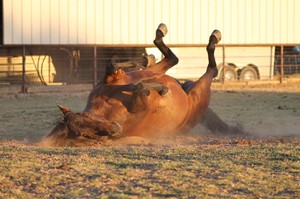Training Your Horse to Express His Blanket Preference…?
Equine Science Update by: Mark Andrews
Most owners think they know when a horse should wear a blanket or go without. Wouldn’t it be interesting to know what the horse thought? Well, research presented at the 10th International Equitation Science Conference, suggests that horses can be taught to use symbols to express their preferences regarding blanketing/rugging.
“Horses can learn to understand the meaning of abstract symbols and to use these to communicate with humans,” stated researcher Cecilie Mejdell. The study was conducted by Mejdell with colleagues Turid Buvik, Grete Jørgensen and Knut Bøe from the Norwegian University of Life Sciences, Norway.
The aim of the project was to teach horses to use symbols to express their preferences regarding blanketing.
Professional animal trainers carried out a ten step training program. Horses were trained for 10-15 minutes per day, 5-7 days a week. Using operant reward based conditioning, horses were trained to approach and touch a board (35 x 35 cm) with the muzzle, firmly and without hesitation.
The training involved association learning between visual symbols on boards and meaning.
One symbol meant “blanket on,” another meant “blanket off.” Once the horses had learned those, a third symbol meaning “no change” was introduced. Horses were deemed to have learnt the meaning of different symbols when they expressed meaningful symbol choices when tested 14 times in a row under pre-determined hot or cold environmental conditions.
All horses that took part in the study, (13 cold-bloods and 10 warm-bloods of various breeds, age 3-16 years) learned to do this. Speed of learning varied between horses. Nevertheless, free choice could be introduced within 13 days for all horses.
At this stage, responses given by horses were not influenced or corrected by the trainers and the horse’s response (its decision regarding blanketing/rugging) was rewarded. From this, it was assumed that the horses understood that their free choice, as expressed by touching a specific symbol, determined the nature of blanketing (i.e. blanket/rug put on, taken off or no change made) and even that they understood the consequence in terms of thermal comfort for the next hours.
The horses’ preferences were tested under differing weather conditions including sunshine, wind, rain/snow and temperatures ranging from -15 to +20 °C. Horses were left outdoors for two hours before being given the choice to change, or not change, blanket status.
Results revealed that the choices made by the horses were individually consistent and influenced by weather conditions. In general, cold-blood horses preferred to stay without a blanket more often compared to warm-bloods.
The researchers conclude that horses can learn to understand the meaning of abstract symbols and to use these to communicate with humans. This provides a promising tool for studying preferences in horses, as in other species. Whether a horses prefers to have a blanket on or off differs between individuals is influenced by weather conditions.
For more details see:
Communication through symbol use: a novel method to study horse preferences for blanketing
Cecilie Mejdell, Turid Buvik, Grete Jørgensen and Knut Bøe
Proceedings 10th International Equitation Science Conference (2014) abstract 13, p33











